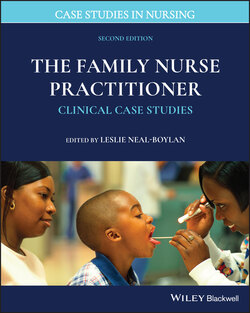Читать книгу The Family Nurse Practitioner - Группа авторов - Страница 34
ОглавлениеCase 4.3 Red Eye
By Andrew Konesky, MSN, APRN
SUBJECTIVE
Will, a 12‐year‐old male, was referred to the school‐based health center (SBHC) at the request of his mother for a red right eye, noticed this morning upon awakening. Will reports waking up this morning with his right eyelid “stuck together like glue.” He reports washing his face and eyes with warm water, allowing him to open his eye. He noticed his eye was “a little red,” but did not report any pain or itch. He has had to wipe his eye a few times since washing his face, as “yellow stuff keeps coming out.” Will reports wearing glasses daily and has never worn contact lenses. He is experiencing no visual disturbances and denies blurriness and double vision. Will’s mother was contacted by the SBHC to provide confirmation of history and further details. His mother denies sick contacts at home, but Will’s cousin, whose house he slept at over the weekend, was given “eye drops” last week by his primary care provider.
Birth history: Will was born full term. His birth weight was 8 lbs 5 oz and birth length was 20 in.
Past medical history: Will has seasonal allergies, which are exacerbated every fall, that are well controlled on daily allergy medication. He has myopia and has been wearing glasses since age 6. He had an appendectomy 2 years ago when he was 10 years old. He has multiple visits to the SBHC for acute, unrelated presentations. He has no further significant history, hospitalizations, or surgeries.
Social history: Will lives with his mother, father, and older sister in a single‐family house. Will is in the seventh grade and plays on the school lacrosse team. He wants to one day be a professional lacrosse player. He is also the team manager for the town’s local hockey team, and enjoys art and music in his spare time. Will has multiple friends at school and a few close friendships.
Diet: Will eats 3 meals a day and reports a normal appetite. He consumes a varied diet of fruits, vegetables, dairy products, and protein sources.
Elimination: Denies difficulty going to the bathroom. Reports regular bowel patterns.
Sleep: Sleeps an average of 8 hours per night. Denies nighttime awakenings, snoring, and restlessness.
Family medical history: Will’s family history is positive for heart disease on his father’s side; his father had a myocardial infarction several years ago. His father may have high blood pressure, but he is not sure. Will denies family history of cancer and or diabetes. His paternal and maternal grandparents are alive and well. He is unsure of his grandparent’s medical history.
Medications: 10 mg Zyrtec daily, Naphcon allergy eye drops as needed, daily multivitamin.
Allergies: Seasonal. No medication allergies reported. No food allergies reported.
OBJECTIVE
General: Male presenting in no acute distress, well hydrated, conversational and appropriate with provider.
Vital signs: Height: 68 in; weight: 135 lbs; BMI: 20.5; BP: 116/70; HR: 75; RR: 16.
Skin: Skin is clear with no rashes noted. Small scar is noted at right lower abdominal quadrant s/p appendectomy. Skin is warm and dry.
HEENT: On examination, right eye is mildly injected, with thick, yellow discharge draining from inner canthus. Dried, yellow crusting is noted across lower lid. Upon cleansing the canthus, discharge reappears spontaneously throughout duration of exam. Pupils are equal and round, reactive to light, with accommodation showing normal pupillary reflex. Visual acuity is 20/20 on Snellen test with corrective lenses. Red reflex is noted and optic discs are without hemorrhage.
Head is normocephalic and atraumatic. Tympanic membranes are clear, intact, with landmarks and cone of light visualized, bilaterally. Nasal turbinates are pale, swollen, and with mild clear discharge. Nasal septum is vertically aligned with no report of pain or discomfort upon palpation of frontal and maxillary sinuses. Oral pharynx is clear with no erythema noted. Tonsils +2 of 4 with no exudate or erythema. Posterior pharynx has minimal post nasal drainage and mild cobbling.
Neck: Supple with full range of motion in all directions. No cervical lymphadenopathy.
Cardiovascular: Regular rate and rhythm. S1/S2 auscultated with no murmur, clicks, rubs, gallops. Equal +2 carotid and radial pulse bilaterally.
Respiratory: Clear to auscultation. No wheezes, rhonchi, rales noted. Good air exchange.
Abdomen: Soft, nontender, nondistended, normal active bowel sounds in all 4 quadrants.
Genitourinary: Deferred.
Neurologic: Alert and oriented. Cranial nerves grossly intact. Good eye contact. Gait normal. Uvula rises midline and symmetrically.
CRITICAL THINKING
1 What are the top three differential diagnoses in this case and why?
2 What are the diagnostic tests required in this case and why?
3 What is the plan of treatment?
4 Are there any standardized guidelines that should be used to treat this case? If so, what are they?
5 What are the plans for follow‐up care and referral?
6 Are there any special examination and or treatment considerations that may affect this case?
